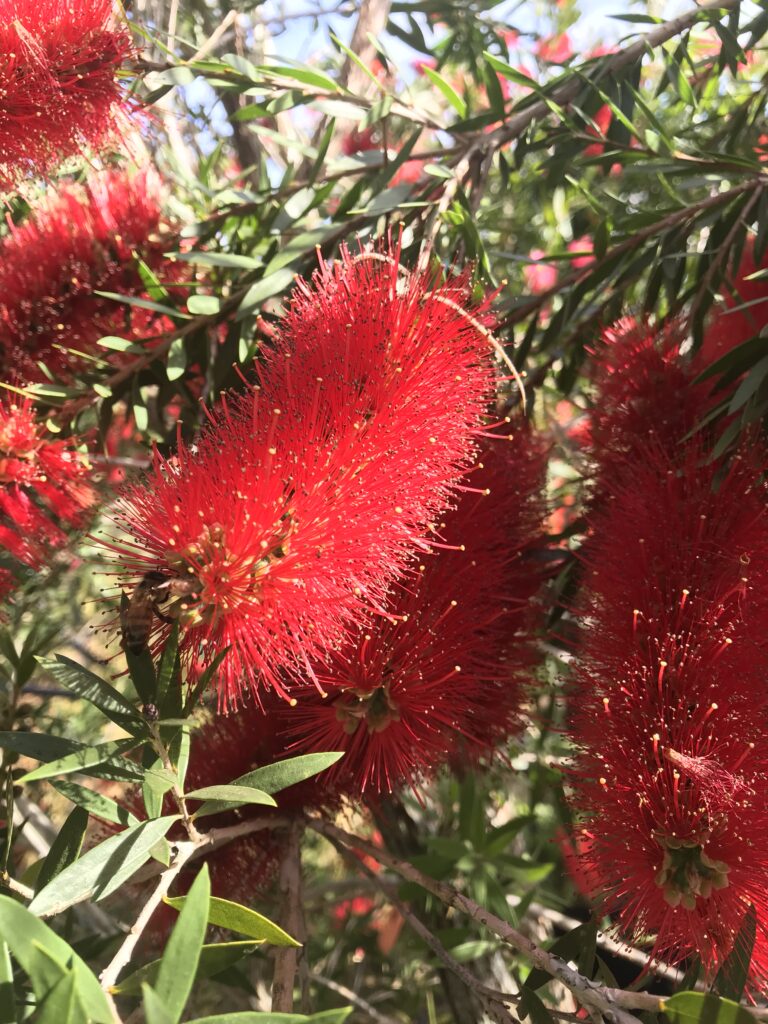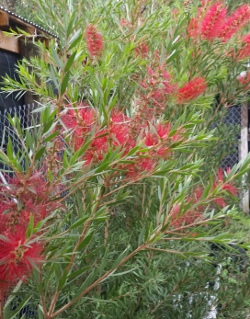S & J Nursery’s Guide to Growing Bottle Brush ‘ Slim ‘ in the Northeast Florida Landscape
( callistemon veminalis CVO1 Slim )
Bottlebrush Origins:
– Callistemon is native to Australia and this is an exciting new introduction from ‘Ozbreed’ that I am incredibly happy to have! Just the thought of it makes me smile. How many times do people fall in love with a bottlebrush tree and end up having to use something like a Podocarpus that while
still beautiful has no bloom or added interest because they have only a narrow space to plant and need the height for privacy but cant have the width of a standard sized bottlebrush. This new selection is the perfect answer! I can hardly wait for the plants to be up to size and ready to be installed in the landscape! Should be ready to go sometime this summer of 2012!!! Limited quantity available.

Bottlebrush Slim Preferred Exposure:
– full sun to light shade
Bottlebrush Slim Foliage | Bark:
– Evergreen foliage is narrow and 3 inches in length, new growth comes out a coppery red color and matures to a bright green
Bottlebrush Slim Soil Preference / Salt Tolerance:
– Bottlebrushes ( callistemon ) are the most tolerant of heat, cold, as well as a wide range of soil conditions.
– drought tolerant once established, however bottlebrush will need consistent water during the establishment period after planting
– bottlebrush are highly salt tolerant
Bottle Brush Slim Size Variance:
– Now were getting to the good part….Bottlebrush slim when left to grow on its own and left untrimmed EVER will only reach about 3 meters high (almost 10 ft) and 1.3 meters wide !!! And that’s with no attempt on your part to trim in to keep it slender! So when pruned on a yearly basis these plants are being kept easily to a width of only 60 cm or only 2 ft wide !!! That’s just unbeatable!

Bottlebrush Slim Growth Habit:
– Columnar upright habit with lush full growth
Slim Bottlebrush Growth Rate:
– extremely fast growth rate, makes an excellent privacy block or screen perfect for tight spaces or smaller backyards and even in-between tightly spaced houses.
Bottlebrush Slim Bloom:
– Bright red elongated blooms resemble a baby bottle brush giving the plant its common name. Bottlebrush will bloom, set buds and rebloom throughout the year.
Bottlebrush Slim Water Requirements:
– not drought tolerant River Birch trees will drop leaves in hot dry weather if no supplemental irrigation is provided
Butterfly or Bird Attracting:
– Attractive to both butterflies and hummingbirds in the North Florida |
Jacksonville | St. Augustine area
Best Uses For Bottlebrush Slim:
– Bottlebrush is a great choice for a privacy screen or large hedge row to block out unsightly sheds, garages or views. Pruned up and allowed to grow as a tree form, bottlebrush make and excellent care free smaller scale ornamental tree. Drought tolerant once established but also will make a good choice for consistently moist soils. Use bottlebrush Slim where additional width on a plant will interfere with walk space or in tight areas including near patios, AC and pool equipment, tightly spaced houses etc.
Care of Bottlebrush Slim:
– Water every day during the establishment period, a bottlebrush tree allowed to dry out during the establishment period runs a high risk of shock, leaves will turn a light tan color and if water is re-applied consistently the leaves will drop and new leaves begin to form within a months time. DO NOT ignore WATERING DAILY ON A NEW BOTTLEBRUSH PLANTING. See watering your newly planted trees for more information.
– They will need good water during the establishment period.
– Provide a 1 ft diameter circle of mulched area where grass is kept from growing for each inch of caliper (or diameter) of trunk measured 4 inches from the ground level.
– Fertilize each spring and summer with a heaping shovel full of well aged compost or a mixture of Milorganite and a slow release poly coated plant food such as Osmocote or Stay Green general purpose plant food, sprinkling the fertilizer around the mulch circle underneath the foliage of the tree or
hedge.

